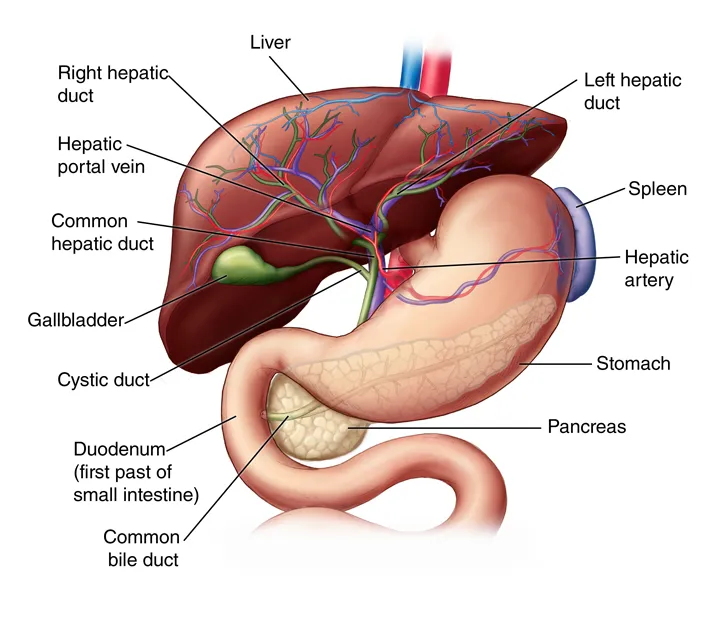Enhance your knowledge of liver anatomy, functions, and diseases with comprehensive biology notes for competitive exams.
Liver
- Positioned in the upper right portion of the abdominal cavity, below the diaphragm.
- Situated above the stomach, right kidney, and intestines.
- Largest gland in the human body.
- Performs crucial functions for the body’s well-being.
- The only organ in the body with this remarkable regenerative capacity.

Read Also: 6 Facts Everyone Should Know About The Liver
Anatomy of the liver
Appearance
- Shaped like a Triangular.
- Dark reddish-brown organ.
- Weighs approximately 3 pounds.
Blood Supply
- Two sources supply blood to the liver:
- Oxygenated blood from the hepatic artery.
- Nutrient-rich blood from the hepatic portal vein.
Blood Volume
- The liver holds about one pint (13%) of the body’s blood supply.
Internal Structure
- Consists of two main lobes.
- Each lobe has eight segments, composed of 1,000 lobules.
- Lobules are connected to small ducts that join larger ducts, forming the common hepatic duct.
- Common hepatic duct transports bile to the gallbladder and duodenum through the common bile duct.
Structural Details
- Triangular and bilobed structure.
- The falciform ligament separates the larger right lobe and smaller left lobe.
- Covered by Glisson’s capsule, a layer of fibrous tissue, which is protected by the peritoneum.
Blood Sources
- Hepatic Portal Vein carries nutrient-rich blood from the digestive system.
- Hepatic Artery carries oxygenated blood from the heart.
Functions of the liver
- Regulates various chemical levels in the blood.
- Produces bile, aiding in waste removal and fat breakdown during digestion.
Blood Processing
- All blood from the stomach and intestines passes through the liver for processing.
- The liver breaks down, balances, and creates nutrients in the blood.
- Metabolizes drugs into user-friendly or non-toxic forms for the body.
Vital Functions
- Over 500 vital functions are identified in the liver.
Well-Known Functions
- Bile production for waste removal and fat breakdown in the small intestine during digestion.
- Synthesis of proteins for blood plasma.
- The production of cholesterol and proteins facilitates fat transport through the body.
- Convert excess glucose into glycogen for storage and glucose balance as needed.
Blood Regulation
- Regulates blood levels of amino acids, essential for protein synthesis.
Haemoglobin Processing
- Processes hemoglobin, storing iron within the liver.
Ammonia Conversion
- Converts poisonous ammonia to urea, excreted in urine.
Detoxification and Immune Support
- Clears blood of drugs and toxins.
- Regulates blood clotting.
- Resists infections by producing immune factors and removing bacteria from the bloodstream.
Bilirubin Clearance
- Clears bilirubin, a by-product of red blood cells.
- Accumulation causes yellowing of the skin and eyes.
By-Product Excretion
- After breaking down harmful substances, by-products are excreted.
- Bile by-products enter the intestine, leaving the body in faeces.
- Blood by-products are filtered by the kidneys, leaving the body in urine.
Regeneration of Liver
- The ability to regrow is present in all vertebrates.
- Functions of the liver remain intact during the regrowth process.
Regeneration Duration
- In humans, regeneration takes approximately 8-15 days.
- In mice, the same process occurs in a shorter timeframe, around 5-7 days.
Liver Diseases
Fascioliasis
- It is caused by a parasite known as the “liver fluke.”
- Parasites can remain inactive in the liver for extended periods, ranging from months to years.
Cirrhosis
- Factors like alcohol consumption, toxins, and hepatitis cause it.
- Scar tissue replaces liver cells, a process called fibrosis, leading to liver cell functionality loss.
- May result in liver failure.
Hepatitis
- Viruses like hepatitis A, B, and C cause inflammation of the liver.
- Often progresses to liver failure.
Alcoholic Liver Disease
- Liver damage caused by excessive alcohol consumption.
- Primary contributor to cirrhosis.
Fatty Liver Disease
- Result of alcohol abuse or obesity.
- Fat accumulates in liver cells, forming vacuoles.
Liver Cancer
- Mainly caused by alcohol and hepatitis.
- Two primary types: Hepatocellular carcinoma and cholangiocarcinoma.

